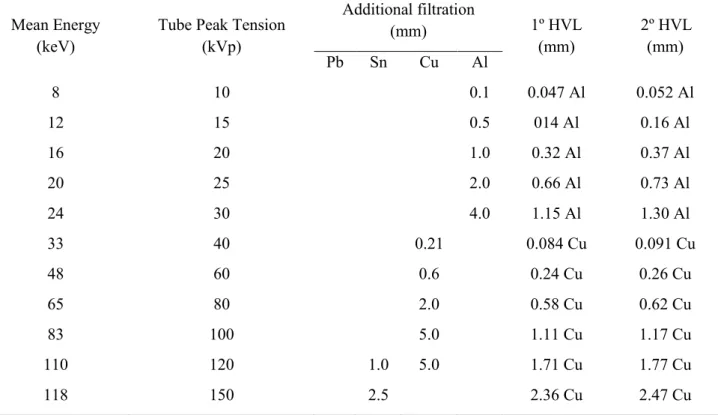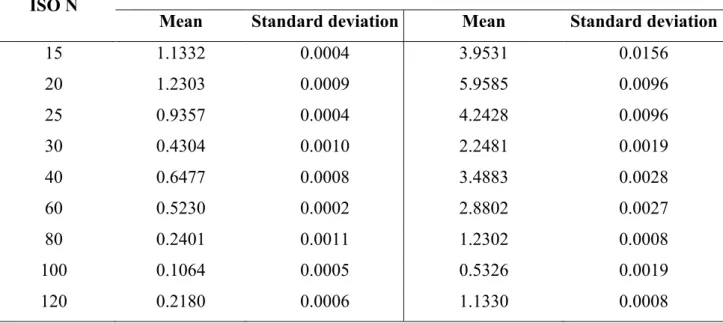BJRS
07-03B (2019) 01-07ISSN: 2319-0612 Accepted: 2019-09-17
Use of a mammography chamber in the
characterization of radioprotection qualities
N15 to N120
Pacifico
aL.C., Peixoto
bJ.G.P.,
aMagalhães L.A.G.
a Laboratory of Radiological Science, University of the State of Rio de Janeiro, Rio de Janeiro, RJ 20550-900, Brazil b National Laboratory of Metrology of Ionizing Radiations, Institute of Radioprotection and Dosimetry, Rio de Janeiro,
RJ 22783-127, Brazil. leonardocpacifico@gmail.com
ABSTRACT
The objective of the present work was to study the feasibility of the use of an ionization chamber dedicated to mammography in the characterization of radioprotection qualities referring to the series of narrow spectrum beams provided by ISO 4037-1. The results were satisfactory, and we conclude that it is feasible to use the ionization chamber dedicated to mammography to characterize the radiation protection qualities ISO-N15 to ISO-N120.
1. INTRODUCTION
The irradiation conditions covered by ISO 4037-1 is to be applied in radiometric survey from mammography to interventionist practices, as well as in the occupational dosimetry [1,2].
Because its low effective energies, such conditions fall into the narrow spectrum series. Each quality is represented by the letter N followed by the peak tension used [3]. The Laboratory of Radiological Sciences of the State University of Rio de Janeiro (LCR / UERJ) characterized the N15 to N150 qualities with the use of two distinct ionization chambers, one dedicated to mammography and the other dedicated to radiological protection.
The objective of the present work was to make a comparative study between both ionization chambers, with the aim of verifying the feasibility of the use a mammography chamber as a reserve one in the LCR, for the ISO-N15 to ISO-N120 qualities.
2. MATERIALS AND METHODS
The two ionization chambers used were: PTW 23361, 30 cm³, cylindrical geometry, energy range 40 keV - 1 MeV, serial number 292, calibrated at LMNRI in 2018 under the number LMNRI 0931/2018, and the Radcal 10X5-6M, 6 cm3, parallel plate geometry, 10 keV-40 keV energy range, serial number 8590, calibrated in the LMNRI in 2017 under the number LMNRI 003/2017.
The X-ray tube used was the Comet industrial type, serial number T20697 / B, with maximum peak tension of 160 kVp, tungsten anode and 20° angulation. The current used was 15 mA. The filtrations consisted of Al, Cu and Sn plates with 99.99% purity and all manufactured by GoodFellow. The focus-detector distance was 1 m. The temperature was between 19° C and 21° C, atmospheric pressure between 99,00 hPa and 101,00 hPa and relative humidity between 50% and 60%.
The measurements were obtained in charge unit coulomb (C), 20 nC scale, on the Keithley electrometer, model 6517A, serial number 6735987 with polarization voltage 300 V. A Casio stopwatch, serial number 208Q09R, certificate and calibration C-0342/17 was used too.
Five measurements of accumulated charge were performed in 1-minute interval. For each ISO-N quality shown in Table 1, the x-ray beam was first characterized with the PTW chamber,
replaced by the Radcal chamber, parallel plate geometry.
For each ISO-N quality, shown in table 1, an attenuation curve was plotted in Excel and a trend line was obtained, and a representative function was got. With this function, the first and second HVLs were calculated, and so the homogeneity coefficient (HC) and the energy dependence.
Table 1: Irradiation conditions for radioprotection covering the narrow spectrum series, according to ISO 4037-1 narrow spectrum beam condition.
Mean Energy
(keV) Tube Peak Tension (kVp)
Additional filtration (mm) 1º HVL (mm) 2º HVL (mm) Pb Sn Cu Al 8 10 0.1 0.047 Al 0.052 Al 12 15 0.5 014 Al 0.16 Al 16 20 1.0 0.32 Al 0.37 Al 20 25 2.0 0.66 Al 0.73 Al 24 30 4.0 1.15 Al 1.30 Al 33 40 0.21 0.084 Cu 0.091 Cu 48 60 0.6 0.24 Cu 0.26 Cu 65 80 2.0 0.58 Cu 0.62 Cu 83 100 5.0 1.11 Cu 1.17 Cu 110 120 1.0 5.0 1.71 Cu 1.77 Cu 118 150 2.5 2.36 Cu 2.47 Cu
The first and second half-value layers (HVL) were obtained and compared with those of references. The relative response variation between the two chambers were given by the ratio of the first HVL of Radcal chamber to the first HVL of PTW chamber, and the HC was obtained by the ratio of the second to the first HVL.
3. RESULTS AND DISCUSSION
Table 2 shows a comparison between the HVL obtained by both ionization chambers, their homogeneity coefficients and the reference values provided by ISO 4037-1. Table 3 shows the mean and its standards deviations for each ISO-N quality measured.
Table 2: Comparison between the first and second HVL and the respective homogeneity coefficients. Values in italics correspond to aluminum thicknesses. The two chambers are identified through its model: 10X5-6M for Radcal and 23361 for PTW.
Additional filtration (nominal) Tension (kVp) 1ª HVL (mm) Al; Cu ISO 4037-1 2ª HVL (mm) Al; Cu 4037-1 ISO HC 10X5-6M 23361 10X5-6M 23361 10X5-6M 23361 0.5 mm Al 15 0.17 0.17 0.14 0.18 0.19 0.16 0.92 0.88 1.0 mm Al 20 0.36 0.38 0.32 0.42 0.43 0.37 0.86 0.88 2.0 mm Al 25 0.68 0.68 0.66 0.80 0.78 0.73 0.85 0.87 4.0 mm Al 30 1.18 1.17 1.15 1.42 1.27 1.30 0.83 0.92 0.20 mm Cu 40 0.076 0.076 0.084 0.077 0.077 0.091 0.99 0.99 0.60 mm Cu 60 0.23 0.22 0.24 0.25 0.26 0.26 0.92 0.85 2.0 mm Cu 80 0.58 0.58 0.58 0.74 0.62 0.62 0.78 0.94 5.0 mm Cu 100 1.23 1.16 1.11 1.37 1.17 1.17 0.90 0.99 0.5 mm Sn +5.0 mm Cu 120 1.75 1.73 1.71 1.90 1.87 1.77 0.92 0.93
ISO N Radcal 10X5-6M PTW 23361
Mean Standard deviation Mean Standard deviation
15 1.1332 0.0004 3.9531 0.0156 20 1.2303 0.0009 5.9585 0.0096 25 0.9357 0.0004 4.2428 0.0096 30 0.4304 0.0010 2.2481 0.0019 40 0.6477 0.0008 3.4883 0.0028 60 0.5230 0.0002 2.8802 0.0027 80 0.2401 0.0011 1.2302 0.0008 100 0.1064 0.0005 0.5326 0.0019 120 0.2180 0.0006 1.1330 0.0008
For the ISO N120 quality, the additional filtration was adjusted to obtain a value close to the first and second HVL required by the ISO 4037-1: 0.5 mm of Sn was subtracted.
For the N10 quality, both chambers had their first and second HVLs equals, which reflect a unitary HC. Considering that the spectrum of the x-ray tube is continuous, a unitary CH does not make sense. A possible cause would be the limitation of Al filters used, with minimum thicknesses of 0.1 mm, which directly influences the profile of the attenuation curves and consequently the HVLs and HC. Another cause would be the energy range itself: the 10 kVp tension corresponds to the 8 keV [3] of effective energy, being below the limit established by both Radcal (which are 10 keV) and considerably below the limit established by PTW (which are 40 keV).
For the ISO-N150 quality, when the Radcal chamber was used, the second HVL was greater than the first HVL, and the HC was greater than one, what is an absurdity. However, it is remembering that the upper limit of effective energy of the Radcal chamber is 40 keV, and for the quality in ques-tion the mean energy is 118 keV [3].
Figure 1 shows the relative response of the Radcal 10X5-6M chamber relative to the PTW 23361 chamber. We observed that the highest energy dependence is 6%, when the extremes are excluded, that is, ISO N10 (10%) and ISO N150 (14%), not shown.
The uncertainties were not considered here and will be analyzed in a future complementary work.
Figure 1: Relative response of the Radcal 10X5-6M chamber relative to the PTW
23361chamber. It was obtained by the ratio of the first Radcal HVL to the first PTW HVL.
4. CONCLUSION
The ISO-N10 and ISO-N150 qualities are not feasible when using the Radcal 10X5-6M ionization chamber, dedicated to mammography, for calibration purposes under the radioprotection radiation conditions provided by ISO 4037-1. However, it can be used in the other qualities, at the price of the increased uncertainty in the calibration process and its possible impact to the end user.
REFERENCES
[1] MELLO, O.A, BORGE, F. L.S, OLIVEIRA, I R., JOANA, G. S, LEYTON, F. NOGUEIRA, M.S. aplicação de metodologia tandem para controle de Qualidade em radioproteção. International Joint Conference RADIO 2014 Gramado, RS, Brazil, August 26-29, 2014 Sociedade brasileira de
radiométrico em mamografia: problemas e desafios. 8° Congresso Brasileiro de Metrologia,
Bento Gonçalves/RS, 2015.
[3] ABNT NBR ISO 4037-1:2015-07-14 X and gamma reference radiation for calibrating dosemeters and dose rate meters and for determining their response as a function of photon energy Part 1: Radiation characteristics and production methods. Rio de Janeiro, 2015.


